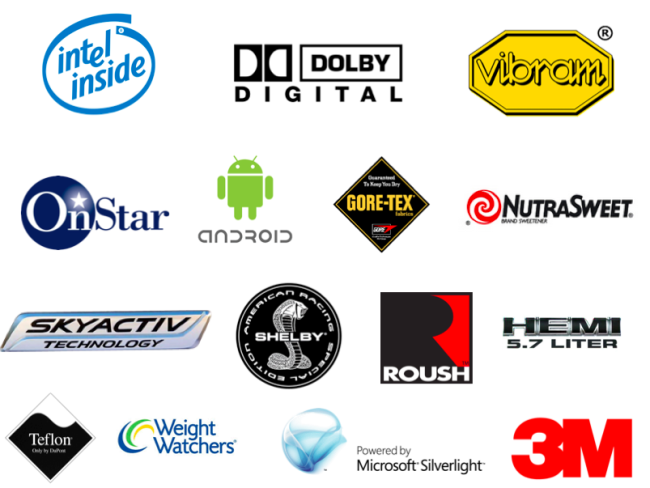The key to B2B branding and marketing is to think of your brand as an ingredient that makes your customer's brand more appealing to their customers. In other words... Are you the secret sauce in your customer's product 'recipe'?
The reason I say this, is because inevitably, there is a customer of the customer for every business – an end user if you like. And it's these end users who are in many cases more important to your intent on growing sales, increasing price and building sustainable brand equity.
The problem for many B2B companies is that they are far removed from the customer's customer and have few of the marketing competencies required to create value for the downstream customer chain.
Unfortunately, many B2B businesses still continue to define their brands around their manufacturing features or distribution capabilities and so end up pushing themselves upon their customers.
Increasingly, these types of companies are facing stiffer competition and an uphill battle to maintain price premiums and sales volumes. Success in these businesses are then determined not by the strength of their brand but rather the quality of their procurement and distribution footprint.
What is Ingredient branding?
Ingredient branding is about branding a product or service that transfers a higher level of quality or utility to the 'host' brand or product. Intel is a great example of this - their memory processing chip makes the computer more valuable than it would be without it. Therefore, ingredient branding is a hybrid approach to branding for B2B companies because they need to be one part consumer marketer and one part customer marketer.
Indeed, the critical element for ingredient branding is the ability to generate demand with the end consumer. By doing this, it allows the ingredient brand to extract better pricing and better supply terms with the 'host' brand because without the ingredient brand the 'host' is more generic or fails to meet the quality benchmark of the category competitors.
One of the reasons we love B2B marketing is this multi-layered challenge that B2B businesses face which requires real strategic and creative thinking not possible in many consumer markets.
Of course B2B businesses face the reality of generating direct sales with customers, however long term, sustainable success for your business is more likely once you embrace the idea of your brand being an ingredient in your customer’s brand experience. As an ingredient brand, the challenge is to make your customer’s brand or product better than if your brand was absent.
The Ingredient Branding Payoff
Becoming an ingredient brand is not easy. It takes time and is not economically cheap in the short term, however once an ingredient brand takes hold with its 'host', it receives a domino effect that's derived from the the customer's brand advertising and promotion to its customers. As a result ingredient brands tend to be more profitable over the long term.
Successful B2B ingredient branding examples

Brands like Intel, Teflon, Nutrasweet and Stainmaster are all great examples for ingredient branding. They are truly brands that end users value and do pay a premium for. In fact as mentioned above, their customers promote their brands for them, often without charge.
Dolby. A transition from ingredient brand to an experience brand
Dolby began in the 1960's with the purpose of reducing the hiss associated with recording on magnetic tape. Dolby's brilliance was in developing technology for both encoding and decoding sound. Importantly, Dolby licensed their technology instead of building factories and infrastructure - they stayed true to their 'why'.
By licensing their brand, Dolby were not only the must have branded ingredient for audio and video recording equipment manufacturers but became the same highly demanded technology for the artists, producers, engineers, and directors that use that equipment.

Dolby has since successfully made the move from home audio, to cinema audio, to video. Dolby could have focused on being an ingredient brand that makes audio better, instead, they have aligned themselves to the experience of the end-user and in doing so have made their business more valuable than if they were still only selling to equipment manufacturers.
Dolby is an ingredient brand, however they have moved beyond being an ingredient. The brand is the experience and they have achieved success well beyond the product ingredient.
Does your brand make your customer's brand experience better?
No matter what industry or category your B2B business operates in, this ingredient brand thinking will simply lead to better relationships with direct customers – customer intimacy is not a bad outcome by the way!
Your B2B brand could be creating value by inputting into end user insights, lead generation and or product innovation. Further to this, ingredient brand thinking can help define the purpose, the competitive set and ultimately the financial engine of the company. Do we need more influence along the value chain? How is this best attained? Through vertical integration, new channels, new end user utility?
Whatever the results of the ingredient branding approach, the likelihood of increased innovation, improved customer intimacy and disruptive thinking are distinct possibilities. Said another way, its pull versus push thinking. It’s not revolutionary, however can you answer the following questions?
Ask yourself - What’s your brands secret sauce ingredient? And for good measure, how does it make your end user brand's experience better?






